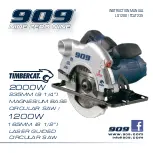
2.
The following precautions must be observed when lifting the saw:
a.
Be sure of your footing.
b.
Keep hands off trigger to avoid accidental operation.
3.
Insure the power supply is turned off. Adjust the blade guard to provide the best operator protection from the angle
of the cut to be made. To adjust the blade guard, loosen the two knobs and rotate the guard to the desired position.
Then retighten the knobs securely.
WARNING:
THE GUARD PROVIDES PROTECTION AGAINST CONTACT WITH MOVING PARTS,
EJECTED DEBRIS, AND DURING WET CUTTING OPERATIONS, THROWN WATER AND
CONCRETE SLURRY. NEVER RUN THE SAW WITHOUT THE BLADE GUARD IN PLACE.
4.
Always check the hydraulic flow and pressure rating of the hydraulic power unit before using to prevent equipment
damage. Do not exceed the maximum hydraulic flow rate and pressure of 8 gpm (30 lpm) and 2500 psi (172 bar).
Overspeeding the blade can cause equipment damage and possible personal injury.
5.
Check that the pressure and return hoses are connected properly to the saw and hydraulic power source as described
in Section 3.1.1.
6.
Before starting your power supply, read and fully understand the operating manual provided.
7.
Use caution when handling fuel for a gasoline engine driven hydraulic power source. Move the hydraulic power
source at least 10 feet from the fueling point before starting the engine. Make sure the gas caps on the hydraulic
power source and fuel can are properly tightened.
3.3
CUTTING PROCEDURE
1.
Provide rigid support and “hold down” of piece being cut—both sides of the cut, if practical.
2.
Grasp the auxiliary handle with your left hand. Use the appropriate part of the handle for making vertical or
horizontal cuts.
3.
Grasp the trigger with your right hand.
4.
Position the saw in the appropriate place to make the desired cut.
5.
Disengage the trigger lockout. Then depress (squeeze) the trigger to start the saw. Never exceed either the blade
maximum operating speed of 4100 rpm or the blade manufacturer’s rated speed.
6.
Feed the rotating blade into the work surface using a straight, steady, constant pressure. Do NOT “bump,” jam or
force the blade into the work surface, or twist the blade in the cut. This can cause equipment damage.
WARNING:
ALWAYS START AND FINISH A SAW CUT WITH THE SAME WIDTH OF BLADE. IF
BLADE TYPE OR WIDTH IS CHANGED, START A NEW SAW CUT. FAILURE TO DO THIS
CAN CAUSE EQUIPMENT DAMAGE AND/OR PERSONAL INJURY.
6
Содержание TS14
Страница 16: ...14 Figure 6 1 TS14 Trenchsaw Assembly...




































